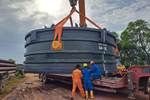Duplicor biocomposite cladding aids redevelopment of ABN AMRO office building in Amsterdam
Chosen for low CO2 footprint, RC value >9, fire resistance, light weight and high strength, Duplicor façade structures are key to two-story extension.
Facade elements for redevelopment of the ABN AMRO building use Duplicor biocomposites. Source | Duplicor
Office redevelopment of Dutch bank ABN AMRO (Amsterdam) has begun. When completed in 2027, it will house almost 11,000 employees and be more sustainable than required by the Paris Climate Agreement — 3 years ahead of ABN AMRO's own target. A key part of this redevelopment is enabled by (the biocomposite brand of Holland Composites, Lelystad, Netherlands) composite façade structures, extending the office complex with a two-story topping. The biocomposite prepreg panels were chosen for their sustainability, low CO2 footprint, high insulation (RC value >9) and light weight combined with high structural strength.
ABN AMRO has set the ambition for all its offices to comply with the Paris Climate Agreement by 2030. The aim of this redevelopment is to renew, expand and “future proof” the existing building, instead of opting for new construction. In addition, 10,500 square meters of solar panels will be installed on the roof and façade to significantly reduce energy consumption.
The Duplicor façade elements will be faced with clay-fired and glazed tile finish to preserve the characteristic architectural value of the original building. In addition, Duplicor’s high fire safety — meeting fire standard B S1 D0 according to NEN-EN 13501 SBI — means there is no flame spread in case of fire.
Duplicor is proud to have worked in collaboration with property developer Edge Technologies, the original building architects Broekbakema, project architects BTC and project manager BAM Bouw en Techniek, to help achieve this renewed green home for ABN AMRO employees.
Related Content
-
Syensqo composites demonstrate titanium replacement on Boeing MQ-25 Stingray
Validation of integrating Cycom 5250-4HT prepreg into the UAV’s exhaust nozzle structure underpins the material system’s use in other high-temperature aerospace applications.
-
Al Seer Marine, Abu Dhabi Maritime unveil world’s largest 3D-printed boat
Holding the new Guinness World Record at 11.98 meters, the 3D-printed composite water taxi used a CEAD Flexbot to print two hulls in less than 12 days.
-
Partners recycle A350 composite production waste into adjustable-length rods for MFFD
Herone, Spiral RTC, Teijin Carbon Europe and Collins Aerospace Almere recycle A350 thermoplastic composite clips/cleats waste into rods for the all-thermoplastic composite Multifunctional Fuselage Demonstrator’s crown.



